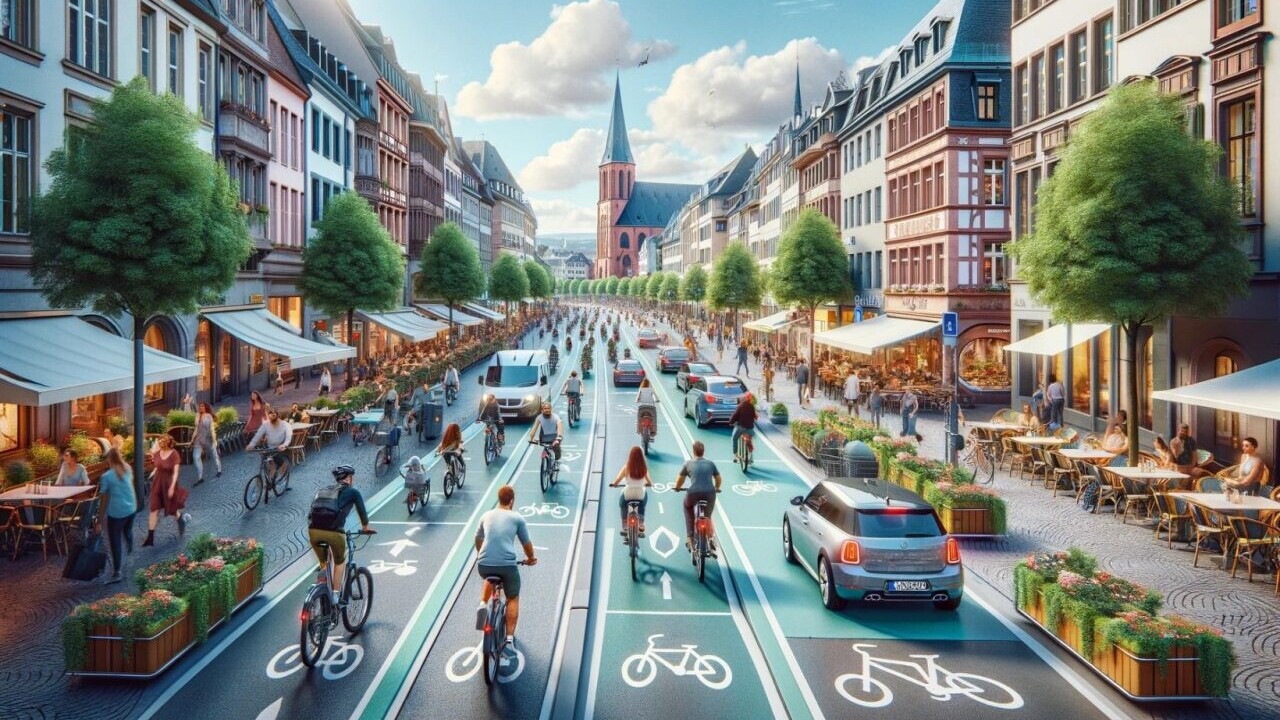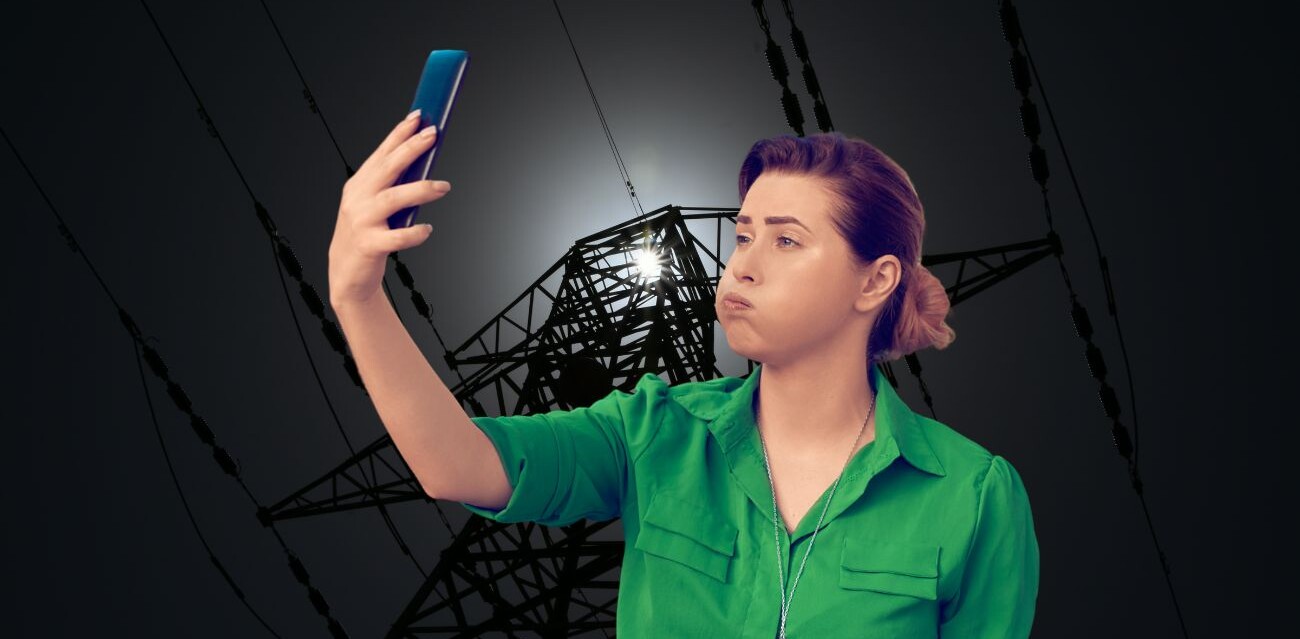
Moving to Amsterdam was eye-opening. Having grown up in the car-centric UK and struggled to cycle in London, it felt as though the Dutch embrace of bikes was innate, something that simply happened due to a quirk of national character.
This, of course, proved incorrect. The Netherlands’ cycle culture didn’t spring from nowhere. Instead, its centrality in day-to-day life was created and planned, rather than miraculously appearing from the heavens.
The postcards and videos also hide the fact that while the Dutch might be leaders in urban cycling, it doesn’t mean they’ve abandoned cars. Far from it. In fact, there are over 9 million cars in the Netherlands, roughly one for each 1.9 people — a figure that was rising up to 2021.
It’s a strange situation to be in. Although the last few years have seen an incredible rise of green transportation and mobility, the most bike-centric nation in the world still relies heavily on cars.
This is one reason the European Declaration on Cycling was signed in spring of this year, to try and help facilitate the shift to a greener way of being. But is it enough?
With climate change accelerating and the need for action increasingly pressing, is it possible for Europe to change? To give up cars and embrace bikes? And how could that happen?
What the stats on bikes vs. cars are saying
To begin with, let’s dive into the data. Surprisingly, there are more bikes of all varieties sold in Europe than cars. In fact, it’s predicted that more than double the amount of bikes than cars will be sold on the continent by 2030.
“Europeans are expected to buy an extra 10 million bikes per year by 2030, a whopping 47% more than in 2019,” Manuel Marsilio, general manager of the Confederation of the European Bicycle Industry (CONEBI) says. This means there will be roughly 30 million new bikes sold in 2030, or “more than twice the number of passenger cars currently registered per year in the EU.”
It seems, then, that bikes are already incredibly popular in Europe. As Anke Schäffner, the chief advocacy officer at ZIV, also known as the German Bicycle Industry explains: “In Germany, bicycles actually outnumber cars in terms of ownership.”
According to Schäffner, there are 84 million bicycles (including ebikes) in the country, compared to 49 million cars. In regards to EVs, there are 11 million ebikes — almost seven times more than 10 years ago — and 1.4 million electric cars.
“I can imagine that Germany is not alone in this regard,” Schäffner says.
When you consider that bicycles globally outsell cars it would appear that things are quite rosy for lovers of green mobility — yet it’s not quite so simple. While bikes are on the rise and, in some European nations, outnumber cars, they’re used substantially less than their petrol-guzzling counterparts.
Studies by the European Commission show that despite the growth of bikes, cars are still the dominant mode of transport on the continent.
Even in the globally-renowned bike haven and geographically compact Netherlands, almost two thirds (62.2%) of distance travelled occurs in cars. Unsurprisingly, this rises substantially in other nations, with the figure reaching 80.6% in Slovenia.
This paints an interesting picture. Bikes are becoming more popular, yet still pale in comparison to cars when it comes to usage across the continent.
The steps to electrification
While Europe is still petrol and car-centric, it’s clear things are changing. Both electric bicycles and cars are becoming more and more popular.
In Germany, for example, ebikes are outselling regular bikes. These vehicles in particular are great car replacements, as they can make travelling longer distances and with loads easier. Plus, talking as someone who commuted on an ebike, you get to work much less sweaty.
So, how has this happened? Why are electric vehicles on the rise? According to Dr. Elizabeth Connelly — energy technology and transport analyst at the International Energy Agency (IEA) — a big reason for this shift towards electrification has been the EU and European countries pushing through various regulations.
This includes “stricter CO2 emission standards for cars and vans to ensure carbon neutrality by 2050,” ambitious CO2 rules for most new trucks and coaches, and the modernisation of rail lines.
This has already had a knock-on effect on electric vehicles, with particular success on cars. “Electric car sales increased by about 20% in 2023,” Dr. Connelly says, “reaching around one-in-four cars sold.”
This is good, right? That we’re moving away from petrol-powered cars to electric ones? On one level, yes, moving away from burning fossil fuels in cars is a huge positive step, but it’s not so simple.
There is a strong argument to move away from cars altogether. Schäffner from the ZIV says there are monumental costs to car usage, whether they’re electric or not. This can include the emissions released by using and creating them, the space they take up in cities, or the “healthcare costs [incurred] due to less physical activity.”
This is why it’s important to not just alter the way we power our vehicles, but also how we use them. As Dr. Connelly stated, electric cars have taken off because of regulatory pressure, so can the same thing work to try and make Europe bike-centric?
Moving butts to bikes
The signs are already there that increased regulation is helping this transport shift. Marsilio from CONEBI says he is “thrilled about the … signing of the European Declaration on Cycling,” something that aims to encourage and support cycling throughout Europe.
This declaration sets out a general policy around cycling, with advice on increasing infrastructure, carving out space, creating cycling networks, and more. There’s a big issue though: none of it is legally binding.
Many of the experts we discussed this with believed regulations need to be far stricter if cycling has any chance of overtaking car usage in Europe.
To achieve this lofty goal, Adrien Roose — CEO and co-founder of electric bike company Cowboy — believes “a multifaceted approach that combines tech innovation, regulatory support, and cultural shifts” is required.
While this covers elements included in the European Declaration on Cycling, Roose says there should be further policies, such as “subsidies for ebike purchases and the development of low-emission zones” across countries.
Both Roose and Marsilio pointed to the success of Amsterdam and Paris as cycle cities as an example of this. With France investing €2 billion in enhancing bike infrastructure and subsidising purchases, this is something many other European countries should copy if bikes will ever become central to transportation.
The tenacity of tech
While regulations and investment are a vital part of getting more people to cycle, technology will play a huge part in making the experience easier and making biking more attractive.
One element that’s already helping — and will accelerate in the coming years — are lowering prices of ebikes themselves. As manufacturing processes improve and mature, more people will have access to the vehicles, and their often prohibitive cost won’t be so much of a burden anymore.
Other advancements can also help these machines become more useful. For example, French company ITEN won an award at CES 2024 for its microbatteries. In the future, this sort of technology can not only give the machines a longer range, but also make them lighter for general users. Many ebikes are currently incredibly heavy, weighing in at around 20 to 25 kg.
Tech can also help with the safety aspect of the shift to cycling. While cities are still designed for cars, there’s an increased danger for cyclists, which can put a lot of people off changing their habits.
Thankfully, there are companies that are confronting this. One such example is Safeware, which has created a wearable airbag vest that automatically inflates and protects the user if they’re involved in an accident.
On the topic of cities, another change that would benefit this shift to cycling would be more ebike charging stations, as well as secure parking facilities. Roose from Cowboy says that theft is often one of the “[main] barrier to purchasing an ebike.” He believes bike companies have to adapt to this, something Cowboy has done with its Find My Bike technology.
Finally, there’s huge scope for VR to help Europe transition into a cycling-centric continent. While many of us are confident cyclists, there’s a swathe of the population that’s less certain about using the machines. In these instances, virtual reality simulations, as well as an increase in cycling courses, can help get people more comfortable with two-wheelers.
All these elements can help encourage people to pick up bikes, yet this won’t be enough on its own.
The need for negativity
We’re all creatures of habit. This is why even though electric cars have been around for years and have substantial subsidies in many countries, they still only make up around one-fifth of car sales.
And that’s just for driving a car you have to “refuel” in a slightly different way. This resistance increases tenfold if you’re trying to encourage people to change their habits entirely and get on their bike instead of inside a car.
That’s why you can’t just encourage, you must discourage individuals too.
Some approaches Dr. Connelly from the IEA suggests include the “phasing out of internal combustion engine vehicles” and “[banning] short-haul flights.” These aggressive approaches will force individuals to travel in new ways.
Schäffner from ZIV goes even further. “Cities have been designed for cars, no longer for people,” she says. The only way to change this and people’s habits is to push in the opposite direction.
With this in mind, “cities have to re-allocate the space” given to cars, meaning that pedestrians and bikes have more space. On top of that, Schäffner believes there needs to be financial negatives too. “Obviously, using a car is still too cheap,” she says. This should lead to higher taxes and tolls on the vehicles. In other words, making car ownership costly.
It’s important to reiterate that this needs to be done alongside positive actions. You can’t simply make driving expensive and tricky if you’re not making cycling incredibly cheap and comfortable simultaneously. Yet the combination of these factors could lead to full cultural change.
A greener bike-centric future
If we’re being honest, it’s unlikely that cars will ever truly disappear — especially in rural areas. Instead, the goal has to be to move away from a car-centric world to a bike-centric one.
This doesn’t just involve bicycles though, as public transport and ridesharing must be improved and easy for people to use, especially in non-urban areas.
While there’s a certain amount of public hunger for a greener society, this transportation shift won’t just happen by itself. Cars are convenient. Unless we can change this and other methods like cycling become cheap and painless, Europe will remain car-centric.
Of course, this is easier said than done. Achieving this will be a decades long mission requiring huge investment and effort. Yet it can happen. The Netherlands shows that it is possible to change a culture. The challenge is making people believe in it.
Get the TNW newsletter
Get the most important tech news in your inbox each week.





